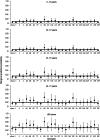Serotype-specific differences in short- and longer-term mortality following invasive pneumococcal disease
- PMID: 27193457
- PMCID: PMC4988273
- DOI: 10.1017/S0950268816000856
Serotype-specific differences in short- and longer-term mortality following invasive pneumococcal disease
Abstract
Invasive pneumococcal disease (IPD), caused by infection with Streptococcus pneumoniae, has a substantial global burden. There are over 90 known serotypes of S. pneumoniae with a considerable body of evidence supporting serotype-specific mortality rates immediately following IPD. This is the first study to consider the association between serotype and longer-term mortality following IPD. Using enhanced surveillance data from the North East of England we assessed both the short-term (30-day) and longer-term (⩽7 years) independent adjusted associations between individual serotypes and mortality following IPD diagnosis using logistic regression and extended Cox proportional hazards models. Of the 1316 cases included in the analysis, 243 [18·5%, 95% confidence interval (CI) 16·4-20·7] died within 30 days of diagnosis. Four serotypes (3, 6A, 9N, 19 F) were significantly associated with overall increased 30-day mortality. Effects were observable only for older adults (⩾60 years). After extension of the window to 12 months and 36 months, one serotype was associated with significantly increased mortality at 12 months (19 F), but no individual serotypes were associated with increased mortality at 36 months. Two serotypes had statistically significant hazard ratios (HR) for longer-term mortality: serotype 1 for reduced mortality (HR 0·51, 95% CI 0·30-0·86) and serotype 9N for increased mortality (HR 2·30, 95% CI 1·29-4·37). The association with serotype 9N was no longer observed after limiting survival analysis to an observation period starting 30 days after diagnosis. This study supports the evidence for associations between serotype and short-term (30-day) mortality following IPD and provides the first evidence for the existence of statistically significant associations between individual serotypes and longer-term variation in mortality following IPD.
Keywords: Mortality; pneumococcal infections; serotype; survival analysis.
Figures





References
-
- O'Brien KL, et al. Burden of disease caused by Streptococcus pneumoniae in children younger than 5 years: global estimates. Lancet 2009; 374: 893–902. - PubMed
-
- Drijkoningen JJC, Rohde GGU. Pneumococcal infection in adults: burden of disease. Clinical Microbiology and Infection 2014; 20 (Suppl. 5): 45–51. - PubMed
-
- Hausdorff WP, Feikin DR, Klugman KP. Epidemiological differences among pneumococcal serotypes. Lancet Infectious Diseases 2005; 5: 83–93. - PubMed
Publication types
MeSH terms
LinkOut - more resources
Full Text Sources
Other Literature Sources
Medical

